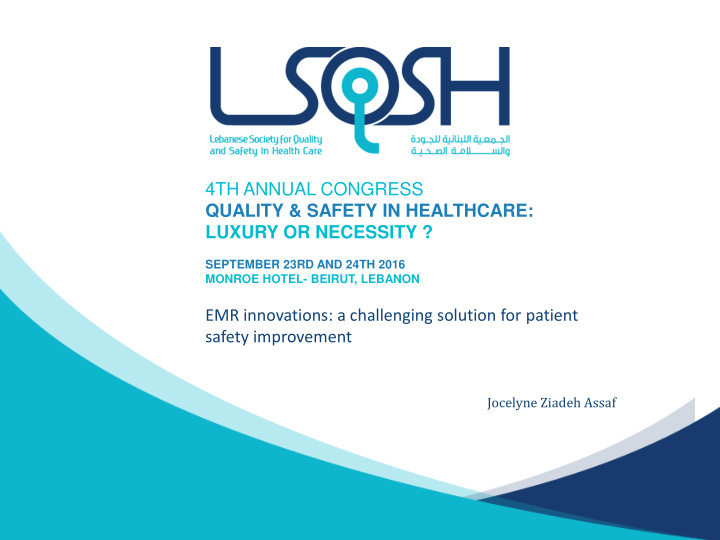



4TH ANNUAL CONGRESS QUALITY & SAFETY IN HEALTHCARE: LUXURY OR NECESSITY ? SEPTEMBER 23RD AND 24TH 2016 MONROE HOTEL- BEIRUT, LEBANON EMR innovations: a challenging solution for patient safety improvement Jocelyne Ziadeh Assaf
Outline • Introduction – Definition (EMR/EHR) – Evolution • Integrated Model for Patient Centered Care • Advantages of EMR: Improving Patient Care and Patient Safety • Potential Risks • Challenges • Recommendations
Introduction Definition: Electronic Health/Medical Record (EHR/EMR) • EMR “ An application environment composed of the clinical data, repository, clinical decision support, controlled medical vocabulary, order entry, computerized provider order entry, pharmacy, and clinical documentation applications . ” The EMR supports the patient’s electronic medical record across inpatient and outpatient environments. The EMR is used by healthcare practitioners to document, monitor, and manage health care delivery within a care delivery organization (CDO) . The EMR is owned by the CDO • EHR “ A subset of each care delivery organization’s EMR is owned by the patient and has patient input and access that spans episodes of care across multiple CDOs within a community, region, or state” The EHR is owned by the patient or stakeholder The EHR can be established only if EMRs of the various CDOs have evolved to a level that can create and support a robust exchange of information Source: https://app.himssanalytics.org/docs/WP_EMR_EHR.pdf
EMR Evolution Connectivity, Mobile technology Health Information Exchange (HIE) + Personal Health Hospital Record Resource Planning (HRP) Electronic Medical Records (EMR) Application and Development (Silos)
Integrated Model for Patient Centered Care LAB Operating Radiology Theater Nursing Pharmacy Patient EMR Admin Ordering Planning-- Automated Billing Scheduler Inventory
Advantages of EMRs Attribute Benefit Immediate and universal access to the Increased efficiency (reduced time spent patient record pulling charts, and duplicate history- taking etc..). Increased quality (better information at the point-of-care) Easier and quicker navigation through the More efficient point of care assessment patient record and data abstraction Increased legibility and Better quality information to aid clinical comprehensiveness, through computer- decision-making and shared care; fewer aided history taking systems and better errors in patient management (eg mis- formatting (templates) prescribing)
Advantages of EMRs Attribute Benefit Secure record keeping No lost records, fewer unnecessary waits or missed appointments, aiding informed patient care. Patient satisfaction. Standardization of care among providers Through better recording and sharing of within the organization information and linkage to CDSS Reduction of paperwork, documentation Removes duplication, reduces processing errors, filing activities time, decreases personnel costs Coding efficiency and efficacy Improved data quality Alerts for medication errors, drug Safer patient care interactions, patient allergies
Advantages of EMRs Attribute Benefit Ability to electronically transmit Fewer delays, more efficient and information to other providers integrated patient care. Enhanced patient (assessments, history, treatments satisfaction. ordered, prescriptions, etc.) Availability of clinical data for use in Better monitoring of quality and quality, risk, utilization, analyses efficiency Availability of non-clinical data Easier management of costs, performance and workflow Availability of data for research With downstream benefits for patient care Adapted from: Healthcare Information and Management Systems Society
Examples on safety improvement • EMRs don't just contain or transmit information; they "compute" it. That means that EMRs manipulate the information in ways that make a difference for patients. For example: – A qualified EMR doesn’t only keep a record of a patient's medications or allergies, it also automatically checks for problems whenever a new medication is prescribed and alerts the clinician to potential conflicts. – Information gathered by a primary care provider and recorded in an EMR tells a clinician in the emergency department about a patient's life-threatening allergy, and emergency staff can adjust care appropriately, even if the patient is unconscious. – EMRs can expose potential safety problems when they occur, helping providers avoid more serious consequences for patients and leading to better patient outcomes.
Potential Risks • Creating new paths to failure. • Distraction miscommunication • Human-Computer Interaction Issues Erroneous or missing data, delaying treatments • Limit interactive conversation, and restrict creative thinking. This may depersonalize and weaken the doctor-patient relationship
Potential Risks • New risks that may lead to harm due to Poorly designed, implemented, or applied EMRs (adding steps to accomplish tasks, or presenting data in a non-intuitive format ,dosing errors, auto-populated fields,.) • Example: Because of “alert fatigue,” there is a danger that doctors may ignore, override, or disable alerts, warnings, reminders, and embedded practice guidelines. If it can be shown that following an alert or a guideline would have prevented an adverse patient event, the doctor may be found liable for failing to follow it.
Challenges • Implementation Strategy/Costs • Patient care time • Privacy & Security : – Potential for breach – User access/disclosure – Stricter definition of secure • Availability of data • Technical Infrastructure (downtime, crashes, viruses..)
Recommendations • Vendor choice: – Smart, flexible, integrated systems: • Assessment tools rather than input tools • Certified for interoperability: ability to interface • Ergonomics – Engage the vendor/integrator in a partnership • Implementation process quality: – Engagement of all the healthcare providers (decision making/validation), user education rather than trainings. – Change management – Communication, Communication& Communication
Recommendations • Infrastructure readiness: Mobility, business continuity and disaster recovery, security • Information security: authorizations/profiles • Continuous auditing and Outcome analysis • Most importantly: Clinical systems readiness – Procedures/Protocols – Guidelines with decision driven flowcharts – Workflows
EMR: A building process Technology tools CDSS and BI Clinical Documentation Certified EHR Technology Infrastructure Clinical Systems : Procedures, Protocols, Workflows
EMR: Provider Learning Curve • Provider learning curve /Adoption/Engagement Need for clinician engagement Improvement of outcomes Reduction of provider & practice risk Usability issues that could result in, or fail to prevent, errors Bugs with potential for patient harm Patient Safety
“Productivity in the healthcare system cannot increase without patient safety first being assured. A key benefit to establishing an EHR system is a corresponding increase in patient safety .” Philip Hassen, President, International Society for Quality and Safety in Health Care
Q&A
Recommend
More recommend